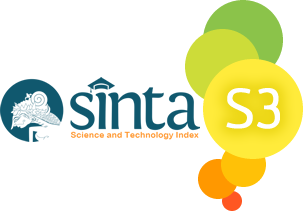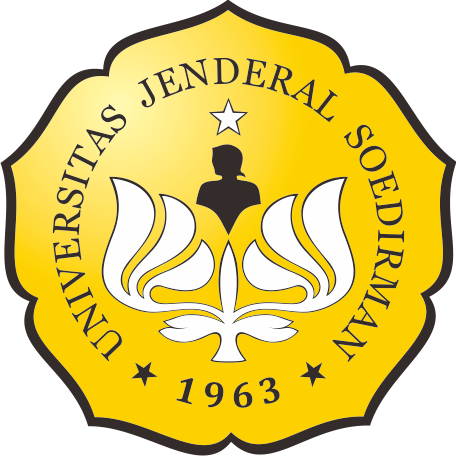VARIASI SEKUENS DNA YANG DIAMPLIFIKASI MENGGUNAKAN PRIMER atpB-rbcL PADA BEBERAPA KULTIVAR KACANG TANAH
Abstract
Peanut is one of food crops commonly consumed in Indonesia. This species comprises several cultivars such as Kancil, Bison, Jerapah, Talam, and Tuban, each of which has its individual advantages and disadvantages. The vast variation among peanut cultivars leads to the need of study on genetic diversity and relationship among them using particular molecular marker. This study aims to see whether variation on DNA sequences among some peanut cultivars amplified with atpB-rbcL primers exists or not and to know the relationship among the cultivars based on the amplicon sequences. The method involves some sequential steps, i.e. genomic DNA isolation using CTAB protocol, amplification of DNA sequence using atpB-rbcL primers and sequencing of the amplification products. Data on sequences were edited manually using Bioedit version 7.0.4.1. Sequence alignment was performed using ClustalW, which is also implemented in Bioedit version 7.0.4.1. Arlequin 2.0 was used to calculate nucleotide diversity p. Phylogenetic analysis was performed using Maximum Parsimony in MEGA 5.0. The results showed that considerably high variation in DNA sequences of some peanut cultivars amplified with atpB-rbcL primers are observed. On the other hands, very close genetic relationship among cultivars is found.
Keywords
References
Agisimanto D, Supriyanto A, 2007. Keragaman genetik pamelo Indonesia berdasarkan Primer Random Amplified Polymorphic DNA. J. Hortikultura 17(1):1–7.
Alberts B, Bray D, Julian L, Raff M, Roberts K, Watson JD. 1994. Biologi Molekuler Sel. Edisi ke-2. Alih Bahasa dari Molecular Biology of The Cell. 2nd Ed. oleh Kantjono AT. Jakarta: Gramedia Utama
Astawan M, 2009. Sehat dengan Hidangan Kacang dan Biji–bijian. Jakarta: Penebar Swadaya, pp.33–35.
Azuma H, Thein LB, Kawano S, 1999. Molecular phylogeny of Magnolia (Magnoliaceae) inferred from cpDNA sequences and evolutionary divergence of the floral scents. J. Plant Research 112:291–306. https://doi.org/10.1007/PL00013885
Bartlett JMS, Stirling D, 2003. PCR Protocols Second Edition. Methods in Molecular Biology. pp. 90–95. https://doi.org/10.1385/1592593844
Campbell, Reece & Mitchell L. 2008. Biologi. Edisi Kedelapan Jilid 1. Jakarta: Erlangga.
Chiang TY, Schaal BA, Peng CI. 1998. Universal primers for amplification and sequencing a noncoding spacer between the atpB and rbcL genes of chloroplast DNA. Botanical Bulletin of Academica Sinica 39:245–250.
Clontech. 1999. Advantage Genomic PCR User Manual. Clontech Laboratories, Inc.
Doi K, Kaga A, Tomooka N, Vaughan DA. 2002. Molecular phylogeny of genus Vigna subgenus Ceratotropis based on rDNA ITS and atpB-rbcL intergenic spacer of cpDNA sequences. Genetica 114:129–145. https://doi.org/10.1023/A:1015158408227
Doyle JJ, Doyle JL. 1990. Isolation of plant DNA from fresh tissue. Focus 12:13–15.
Fachruddin L. 2000. Budidaya Kacang–Kacangan. Yogyakarta: Kanisius, pp.13–15.
Fujii N, Ueda K, Watano Y, Shimizu T. 1997. Intra-specific sequence variation of chloroplast DNA in Pedicularis chamissonis Steven (Scrophulariaceae) and geographic structuring of the Japanese 'alpine' plants. J. Plant Research 110:195–207. https://doi.org/10.1007/BF02509308
Grant PR, Grant BR. 1994. Phenotypic and genetic effects of hybridization in Darwin's finches. Evolution 48:297–316. https://doi.org/10.2307/2410094
Hall BG. 2001. Phylogenetic Tress Made Easy : A How-To Manual for Molecular Biologis. Sinauer Associates, Inc., Sunderland
Hartl DL, Jones EW. 1998. Genetics: principles and analysis. fourth edition. Jones and Bartlett Publishers. Inc, United Stated of America.
Huang SSF, Hwang SY, Lin TP. 2002. Spatial pattern of chloroplast DNA variation of Cyclobalanopsis glauca in Taiwan and East Asia. Molecular Ecology 11:2349–2358. https://doi.org/10.1046/j.1365-294X.2002.01624.x
Johnson JL. 1973. Use of nucleic–acid homologies in the taxonomy of anaerobic bacteria. International Journal of Systematic Bacteriology 23(4):308–315. https://doi.org/10.1099/00207713-23-4-308
Kementerian Pertanian RI., 2012. Laporan Akuntabilitas Kinerja Instansi Pemerintah (Lakip). Jakarta: Direktorat Jenderal Tanaman Pangan, pp. 35–27.
Kolondam BJ, Lengkong E, Mandang JP, Pinaria P, Runtunuwu S. 2012. Barcode DNA berdasarkan gen rbcL dan matK Anggrek Payus Limondok (Phius tancarvilleae), J. Bioslogos 2(2):1–8.
Nei M. 1972. Genetic Distance Between Population. The American Naturalist 106(949):283–292. https://doi.org/10.1086/282771
Nei M. 1987. Molecular Evolutionary Genetics. New York: Columbia University Press.
Nei M, Li WH. 1979. Mathematical model for studying genetic variation in terms of restriction endonucleases. Proceedings of the National Academy od Sciences 76:5269–5273. https://doi.org/10.1073/pnas.76.10.5269
Nie Z, Wen J, Sun H, Bartholomew B. 2005. Monophyly of Kelloggia Torrey ex Benth. (Rubiaceae) and evolution of it sinter continental disjunction between western north America and eastern Asia. American Journal of Botany 92(4):642–652. https://doi.org/10.3732/ajb.92.4.642
Prana TK, Hartati SN. 2003. Identifikasi sidik jari DNA talas (Colocasia esculenta L. Schott) Indonesia dengan teknik RAPD: Skrining primer dan optimalisasi kondisi PCR. J. Natur Indonesia 5(2):107–112.
Rahayu SE, Handayani S. 2010. Keragaman genetik pandan asal Jawa Barat berdasarkan penanda inter simple sequence repeat. Makara Sains 14(2):158–162.
Sambrook J, Russell DW. 2001. Molecular cloning a laboratory Manual. Cold Spring Harbor Laboratory Press. New York.
Schneider S, Roessli D, Excoffier L. 2000. Arlequin: A Sofware for Population Genetic Data Analysis. Genetics and Biometry. University of Geneva. Geneva. Switzerland
Soelistiyowati DT. 1996. Genetika Populasi. Jurusan Budidaya Perairan. Fakultas Perikanan. Institut Pertanian Bogor. Bogor
Sudarmi. 2013. Peranan biologi molekuler pada pemuliaan tanaman. Magistra 84(25):75.
Suryanto D. 2003. Melihat Keanekaragaman Organisme Melalui Beberapa Teknik Genetika Molekuler. [Skripsi]. Fakultas Matematika dan Ilmu Pengetahuan Alam Universitas Sumatera Utara.
Tajima F. 1993. Measurement of DNA Polymorphism. In: Mechanisms of Molecular Evolution. Introduction to Molecular Paleopopulation Biology, Edited by Takahata N, Clark AG, Tokyo, Sunderland, MA: Japan Scientific Societies Press, Sinauer Associates, Inc., pp.37–59.
Tamura K, Peterson D, Peterson N, Stecher G, Nei M, Kumar S. 011. MEGA5: Molecular Evolutionary Genetics Analysis Using Maximum Likelihood, Evolutionary Distance, and Maximum Parsimony Methods. Molecular Biology Evolution 28(10):2731–2739. https://doi.org/10.1093/molbev/msr121
Thompson JD, Higgins DG, Gibson TJ. 1994. CLUSTALW: improving the sensitivity of progressive multiple sequence alignment through sequence weighting, position-specific gapspenalties and weight matrix choice. Nuclei Acids Research 22:4673–460. https://doi.org/10.1093/nar/22.22.4673
Article Reads
Total: 30393 Abstract: 2433 HTML: 23685 PDF: 4275Refbacks
- There are currently no refbacks.

This work is licensed under a Creative Commons Attribution-ShareAlike 4.0 International License.
This website is maintained by:
Bio Publisher
The Faculty of Biology Publishing
Faculty of Biology
Universitas Jenderal Soedirman
Jalan dr. Suparno 63 Grendeng
Purwokerto 53122
Telephone: +62-281-625865
Email: biologi@unsoed.ac.id
T his website uses:
OJS | Open Journal System
A free journal management and publishing system that has been developed by the PKP (Public Knowledge Project) version 2.4.8.0.
All article content metadata are registered to:
Crossref
An official nonprofit Registration Agency of the International Digital Object Identifier (DOI) Foundation.
Articles in this journal are indexed by:









